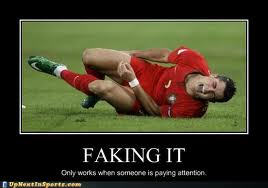
it really hurts;I cannot possibly get up; at least not until my opponent has received a yellow card...
Judging from both the internet broadcasts and reports from those who were present, the recent Men’s Junior World Championship in Greece was a predominantly positive experience. The performance of many teams and the skills of individual players showed a lot of promise for the future. Moreover, the attitude of most players and team officials reflected an unusual sense of sportsmanship in most respects. Teams generally seemed to put an emphasis on technical and tactical weapons rather than on physical or rough play.
But as a contrast, it was impossible to ignore a certain prevalence of ‘acting’ on the part of players who were (or wanted to give the impression of being) fouled, and then spent a considerable amount of time on the floor, writhing in pain and grimacing frantically. On many occasions, the ‘acting’ seemed to be totally out of proportion in relation to the very modest body contact that had taken place. And, of course, it caused many seemingly unnecessary and protracted stoppages in the action. The referees tried their best to get the game going again, but often without much success. All in all, a frustrating component of an otherwise attractive game.
Clearly, this is not a feature that we find only, or mainly, in handball. It is not surprising that the best photo illustration I found was from football. Here the players, especially at the professional level, have turned it into ‘gamesmanship’, using it systematically to cause unwarranted refereeing decisions, including punishments against opponents. It was interesting to note, however, that the problem was less common in the recent Women’s World Championship in football. Are the women sturdier, or are they simply more inclined to adhere to a spirit of fair play?
Similarly, in handball the problem tends to be less severe at the youth/junior level than among the adult players. This may have something to do with a ‘macho’ attitude among the younger players, or it may simply mean that they have not yet been ‘brainwashed’ by coaches into adopting the unsportsmanlike methods instinctively. But it has also been quite clear to me over the years, as a participant in numerous senior and junior events, that the issue is also ‘cultural’ in nature. The tendency to this unattractive acting is much stronger among players and teams from certain regions, particularly North Africa and West Asia.
Here again one may wonder what is the cause. Is it an indication of particularly bad sportsmanship in those regions, and if so why? Or, if it happens so often at the youth level, is it really ‘cultural’ and something that comes with upbringing and engrained habits? I have no expertise in such matters; I simply find it puzzling. In recent months there has been worldwide admiration for the courage, maturity and physical/mental resilience on the part of the youth in precisely these regions, with a totally absence of self-pity and ‘drama’. How can it be that the tendencies on a football field or handball court are so completely different?
